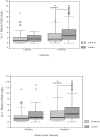Non-alcoholic fatty liver disease is closely associated with sub-clinical inflammation: a case-control study on Asian Indians in North India
- PMID: 23326306
- PMCID: PMC3543427
- DOI: 10.1371/journal.pone.0049286
Non-alcoholic fatty liver disease is closely associated with sub-clinical inflammation: a case-control study on Asian Indians in North India
Abstract
Objectives: Association between sub-clinical inflammation and non-alcoholic fatty liver disease (NAFLD) has not been studied in Asian Indians. In this case-control study, we aimed to analyse association of NAFLD with the sub-clinical inflammation and metabolic profile in Asian Indians in north India.
Methods: Ultrasound diagnosed 120 cases of NAFLD were compared to 152 healthy controls without NAFLD. Anthropometric profile [body mass index (BMI), waist circumference (WC), hip circumference (HC)], high-sensitivity C-reactive protein (hs-CRP), metabolic profile [fasting blood glucose (FBG), lipid profile] and hepatic function tests [alanine aminotransferase (ALT) and aspartate aminotransferase (AST)] were recorded.
Results: Metabolic parameters [FBG, total cholesterol (TC), serum triglycerides (TG),low-density lipoprotein (LDL-c)], hs-CRP and prevalence of the metabolic syndrome were higher in cases as compared to controls (p-value<0.05 for all). The median (range) of hs-CRP (mg/L) for cases [2.6(0.2-13.4)] were significantly higher than in controls [1.4(0.03-11.4), p = 0.01]. Similarly, higher values of hs-CRP were obtained when subgroups of cases with obesity, abdominal obesity and the metabolic syndrome were compared to controls [2.75 (0.03-14.3) vs. 1.52 (0.04-14.3), p = 0.0010; 2.8 (0.03-14.3) vs. 1.5 (0.06-14.3), p = 0.0014 and 2.7 (0.5-14.3) vs. 1.6 (0.06-8.5), p = 0.0013, respectively. On multivariate logistic regression analysis BMI (p = 0.001), WC (p = 0.001), FBG (p = 0.002), TC (p = 0.008), TG (p = 0.002), blood pressure (p = 0.005), metabolic syndrome (p = 0.001) and hs-CRP (p = 0.003) were significantly and independently associated with NAFLD. After adjusting for significant variables, the association between high hs-CRP and NAFLD remained large and statistically significant [adjusted OR = 1.17, 95% confidence interval (CI) = 1.05-1.29]. An increase in 1 mg/dl of hs-CRP level calculated to increase the risk of developing NAFLD by 1.7 times as compared to controls after adjusting for significant variables associated with NAFLD.
Conclusions: In this cohort of Asian Indians in North India, presence of NAFLD showed independent relationships with sub-clinical inflammation.
Conflict of interest statement
Figures

Similar articles
-
A case-control study on insulin resistance, metabolic co-variates & prediction score in non-alcoholic fatty liver disease.Indian J Med Res. 2009 Mar;129(3):285-92. Indian J Med Res. 2009. PMID: 19491421
-
Genetic variation in the patatin-like phospholipase domain-containing protein-3 (PNPLA-3) gene in Asian Indians with nonalcoholic fatty liver disease.Metab Syndr Relat Disord. 2013 Oct;11(5):329-35. doi: 10.1089/met.2012.0064. Epub 2013 Jun 4. Metab Syndr Relat Disord. 2013. PMID: 23734760
-
SREBP-2 1784 G/C genotype is associated with non-alcoholic fatty liver disease in north Indians.Dis Markers. 2011;31(6):371-7. doi: 10.3233/DMA-2011-0852. Dis Markers. 2011. PMID: 22182810 Free PMC article.
-
Prebiotic and probiotic treatment of nonalcoholic fatty liver disease: a systematic review and meta-analysis.Nutr Rev. 2018 Nov 1;76(11):822-839. doi: 10.1093/nutrit/nuy031. Nutr Rev. 2018. PMID: 30113661
-
Efficacy of synbiotic supplementation in patients with nonalcoholic fatty liver disease: A systematic review and meta-analysis of clinical trials: Synbiotic supplementation and NAFLD.Crit Rev Food Sci Nutr. 2019;59(15):2494-2505. doi: 10.1080/10408398.2018.1458021. Epub 2018 Apr 20. Crit Rev Food Sci Nutr. 2019. PMID: 29584449
Cited by
-
Screening of Cardiovascular Disease in Nonalcoholic Fatty Liver Disease: Whom and How?J Clin Exp Hepatol. 2019 Jul-Aug;9(4):506-514. doi: 10.1016/j.jceh.2019.02.005. Epub 2019 Feb 15. J Clin Exp Hepatol. 2019. PMID: 31516267 Free PMC article. Review.
-
High-Sensitive CRP Correlates With the Severity of Liver Steatosis and Fibrosis in Obese Patients With Metabolic Dysfunction Associated Fatty Liver Disease.Front Endocrinol (Lausanne). 2022 May 6;13:848937. doi: 10.3389/fendo.2022.848937. eCollection 2022. Front Endocrinol (Lausanne). 2022. PMID: 35620390 Free PMC article.
-
Effect of garlic powder supplementation on blood pressure and hs-C-reactive protein among nonalcoholic fatty liver disease patients: A randomized, double-blind, placebo-controlled trial.Food Sci Nutr. 2021 May 6;9(7):3556-3562. doi: 10.1002/fsn3.2307. eCollection 2021 Jul. Food Sci Nutr. 2021. PMID: 34262716 Free PMC article.
-
Nonalcoholic Fatty Liver Disease in South Asia.Euroasian J Hepatogastroenterol. 2016 Jul-Dec;6(2):154-162. doi: 10.5005/jp-journals-10018-1189. Epub 2016 Dec 1. Euroasian J Hepatogastroenterol. 2016. PMID: 29201749 Free PMC article. Review.
-
Non-alcoholic fatty liver disease is an independent risk factor for inflammation in obstructive sleep apnea syndrome in obese Asian Indians.Sleep Breath. 2019 Mar;23(1):171-178. doi: 10.1007/s11325-018-1678-7. Epub 2018 Jul 22. Sleep Breath. 2019. PMID: 30032465
References
-
- Ridker PM, Buring JE, Cook NR, Rifai N (2003) C-reactive protein, the metabolic syndrome, and risk of incident cardiovascular events: an 8-year follow-up of 14 719 initially healthy American women. Circulation 107: 391–7. - PubMed
-
- Barzilay JI, Abraham L, Heckbert SR, Cushman M, Kuller LH, et al. (2001) The relation of markers of inflammation to the development of glucose disorders in the elderly: the Cardiovascular Health Study. Diabetes 50: 2384–9. - PubMed
-
- Ridker PM, Rifai N, Cook NR, Bradwin G, Buring JE (2005) Non-HDL cholesterol, apolipoproteins A-I and B100, standard lipid measures, lipid ratios, and CRP as risk factors for cardiovascular disease in women. Jama 294: 326–33. - PubMed
-
- Vikram NK, Misra A, Dwivedi M, Sharma R, Pandey RM, et al. (2003) Correlations of C-reactive protein levels with anthropometric profile, percentage of body fat and lipids in healthy adolescents and young adults in urban North India. Atherosclerosis 168: 305–13. - PubMed
-
- Socha P, Wierzbicka A, Neuhoff-Murawska J, Wlodarek D, Podlesny J, et al. (2007) Nonalcoholic fatty liver disease as a feature of the metabolic syndrome. Rocz Panstw Zakl Hig 58: 129–37. - PubMed
Publication types
MeSH terms
Substances
LinkOut - more resources
Full Text Sources
Other Literature Sources
Research Materials
Miscellaneous

